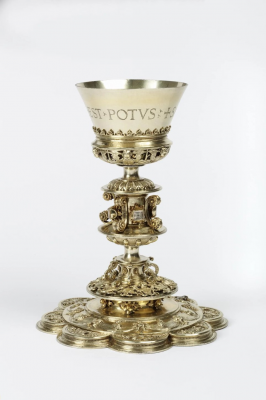Gospel in Art: My blood is real drink

Spanish silver-gilt chalice, Burgos, Spain, 1549. Engraved 'SANGUIS MEUS VERE EST POTUS' © V&A Museum
Source: Christian Art
Gospel of 19 April 2024
John 6:52-59
The Jews started arguing with one another: 'How can this man give us his flesh to eat?' they said. Jesus replied: 'I tell you most solemnly, if you do not eat the flesh of the Son of Man and drink his blood, you will not have life in you. Anyone who does eat my flesh and drink my blood has eternal life, and I shall raise him up on the last day.
For my flesh is real food and my blood is real drink. He who eats my flesh and drinks my blood lives in me and I live in him. As I, who am sent by the living Father, myself draw life from the Father, so whoever eats me will draw life from me. This is the bread come down from heaven; not like the bread our ancestors ate: they are dead, but anyone who eats this bread will live for ever.'
He taught this doctrine at Capernaum, in the synagogue.
Reflection on the chalice
The question the Jews ask in this morning's Gospel reading - 'How can this man give us his flesh to eat?'- is an understandable one. The language Jesus had used about eating his flesh was shocking. After the question Jesus went on to speak not only of eating his flesh but of drinking his blood, which would have sounded even more shocking. Yet, it is language which expresses the depth of communion which Jesus wants to create between himself and his disciples, the theme of the Gospel readings this week.
If we therefore truly believe that the blood of Christ is real, we want to use the most beautiful of receptacles to hold this blood: a chalice. It is generally believed that the first chalices were made of wood and it was not till the recognition of Christianity in the early 4th century in the Roman Empire that silver and gold became the more standard materials for the chalice. The very best of materials to hold the most precious blood. Throughout the ages, additions of semi-precious stones, engravings, enamelling and any further embellishments have given chalices a major part in the history of ecclesiastical art and always reflected contemporary tastes and stylistic eras.
The Spanish chalice shown here has a conical bowl engraved 'SANGUIS MEUS VERE EST POTUS': 'My blood is truly a libation'. The spectacular looking stem is inset with four square rock crystals. Rock crystal is the purest variety of quartz and is transparent and completely colourless. Remember that these vessels would have stood out even more in churches when candlelight was the only sourced of light. The gold and silver would have been noticeable from the very back of the church, thus accentuating the very centre of the Eucharist, especially when being held aloft by the priest during the moment of consecration.
'SANGUIS MEUS VERE EST POTUS',
My blood is truly a libation, my blood truly is real drink.
LINKS
Gospel in Art: https://christian.art/
Today's Reflection: https://christian.art/daily-gospel-reading/john-6-52-59-2024/
Competition: The Laudamus Award 2024 for Sacred Art - www.indcatholicnews.com/news/4931


















